Barcelona got lucky in getting the much needed three points against Villarreal, but their performance was far from what it is expected to be. The Yellow Submarine were defeated by two beautiful goals by Griezmann and Arthur, but deserves praise for trying until the very end.
The talking points for Barcelona were Messi’s injury and Griezmann’s future in the team, whilst Villarreal found their “new” hero in the face of Santi Cazorla.
This tactical analysis will look into both team’s tactics and how, despite their struggles, Barcelona found a way to grab the three points.
Lineups
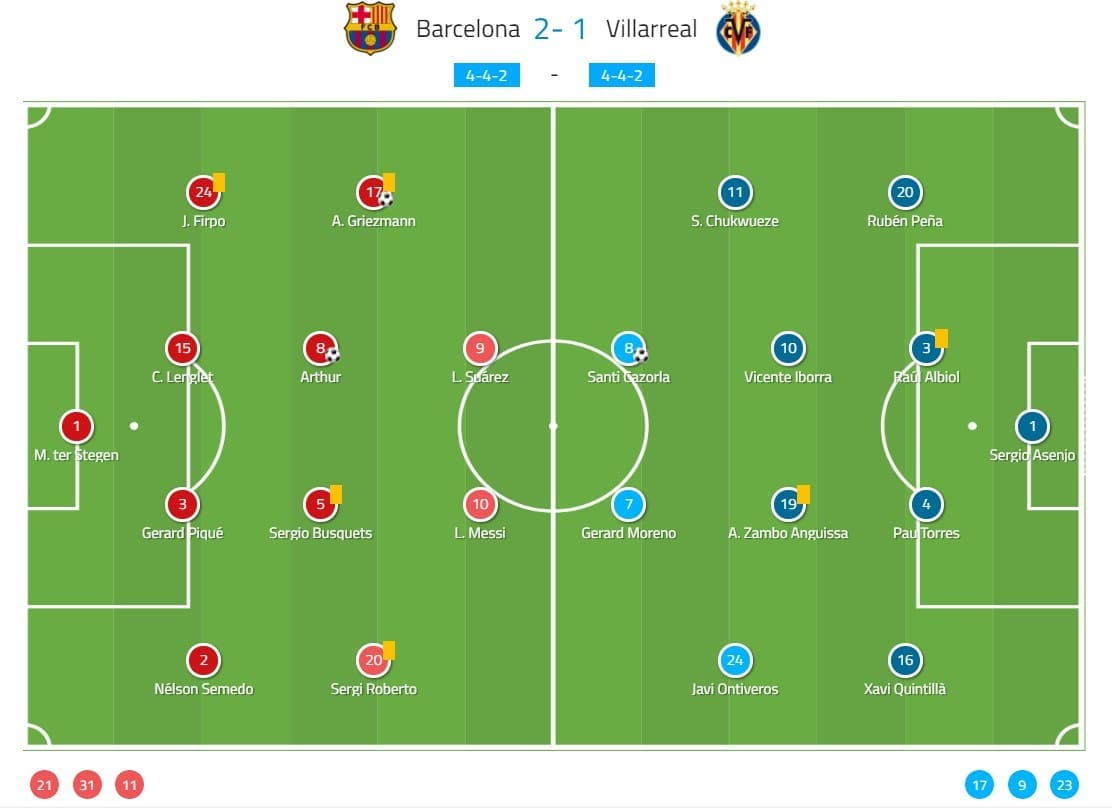
Barcelona initially lined up in a 4-3-3 formation. Martin ter Stegen was on the goalkeeping spot while supported by a four-man defence containing Nélson Semedo, Gerard Piqué, Clément Lenglet, and Junior Firpo. Sergi Roberto, Sergio Busquets, Arthur were in the role of the central trio. Luiz Suárez was leading the attack, flanked by Lionel Messi and Antoine Griezmann. The team had to change their strategy multiple times, though. It all started with Messi being forced off and then trying to structure in a right way in order to create more opportunities, ending up in a 4-1-4-1 scheme.
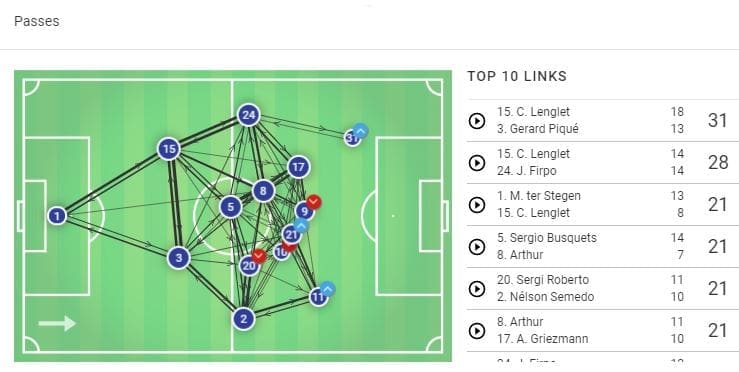
Villarreal’s 4-2-3-1 starting XI started with Sergio Asenjo. In front of him were Rubén Peña, Raúl Albiol, Pau Torres and Xavi Quintillà. The central duo were Vicente Iborra and André-Frank Zambo Anguissa with Samuel Chukwueze, with Santi Cazorla and Javi Ontiveros in front of them. To finish off, Javier Calleja relied on Gerard Moreno. The 34-year-old Cazorla was the main threat in front of Ter Stegen’s goal combining his vision and passing abilities with some finishing chances on his own. He ended up as the only Villarreal goalscorer.
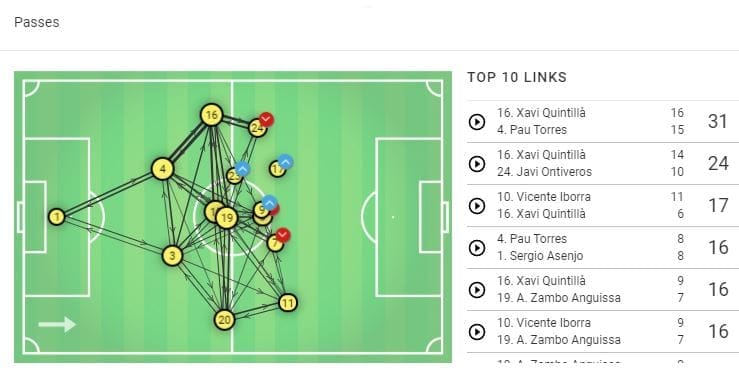
Barcelona’s growing problems
Barcelona might have won, but their growing problems in some areas were evident throughout the whole game. The two scored goals didn’t actually show the real situation as the Blaugrana have a lot to work on in the final third. This might sound ridiculous having in mind the set of players that they could rely on, but it is the ugly truth. And there are a few focal points as to why their attacking ventures are not as efficient as they should be.
With players like Messi, Suárez and Griezmann, and later the youngsters Dembélé and Fati, the team managed to shoot only eight times, with half of their shots being on target. Overall, 50% success rate is not that poor of a performance, but there are different factors that make it slightly unsatisfying when it comes to this game.
Villarreal did have a clear vision about their defensive structure when out of possession and that was helping a lot in the early stages of the game. They didn’t seem to have a clear plan on their marking during the defensive transitions though. They would use man-to-man marking when in the middle third, but most often switched to zonal marking in their defensive third and especially around the box. This would often be crucial especially when defending long balls and set-pieces, as it could be seen by the two conceded goals. So, it is not Villarreal’s defensive line that weren’t allowing Barca to create chances.
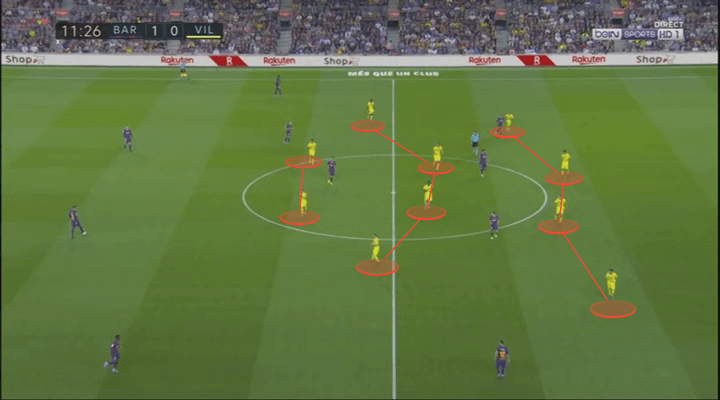
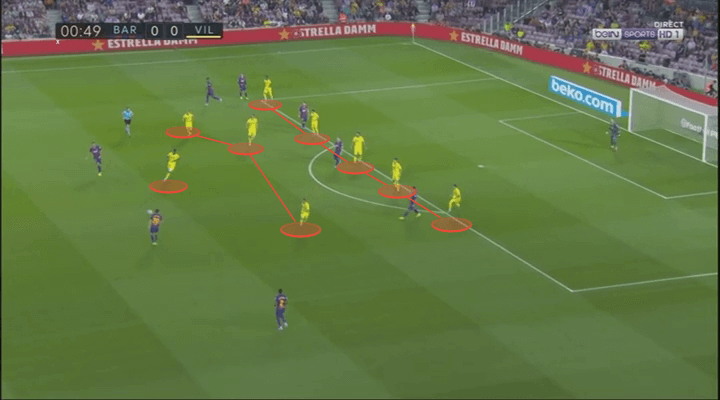
It was more of the team’s attacking players’ link-up-play and versatility. It seems that Valverde experiences real struggles when it comes to picking his starting XI and using players at their natural positions. Even though Griezmann opened the scoring with his header, he is the one who struggles to find his place in the team and combine well with his fellow attackers. And it had more to do with his positioning rather than his abilities.
The Frenchman would often be left isolated. He covered wide areas on the pitch and moved frequently off the ball, but the lack of support by his teammates resulted in a few missed opportunities. And the same goes for Suárez, as his movement wasn’t complimenting the others’ actions. Not being used in a front two affects Griezmann’s performance immensely as he couldn’t use his explosiveness and runs to the box. The French international managed to shoot three times and all of them were when he was out of his position, drifting in the central areas.
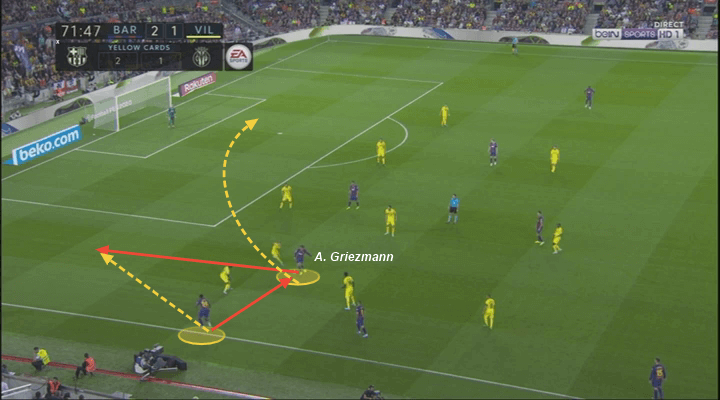
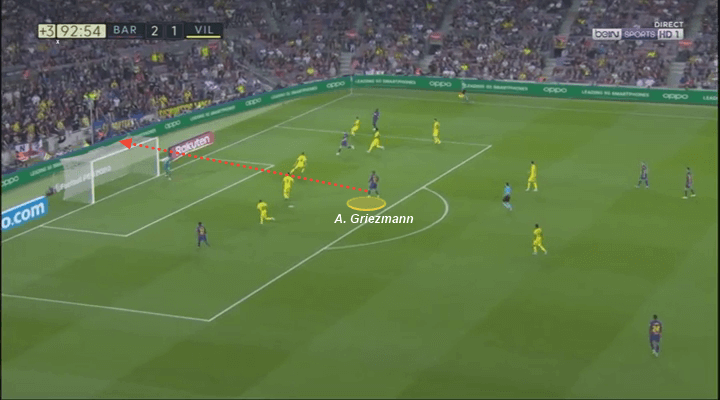
Villarreal’s defensive efforts
Villarreal weren’t applying much pressure on the ball carrier (unless it was Messi) and gave too much freedom to the Barcelona players to control the game and create short pass combinations. That is partly a result of Barca’s players quickly circulating the ball and not allowing their opponents any time on it. That is one of the reasons for allowing Arthur to shoot his impressive strike- Messi dragged three players with his movement and that left Arthur completely uncovered.
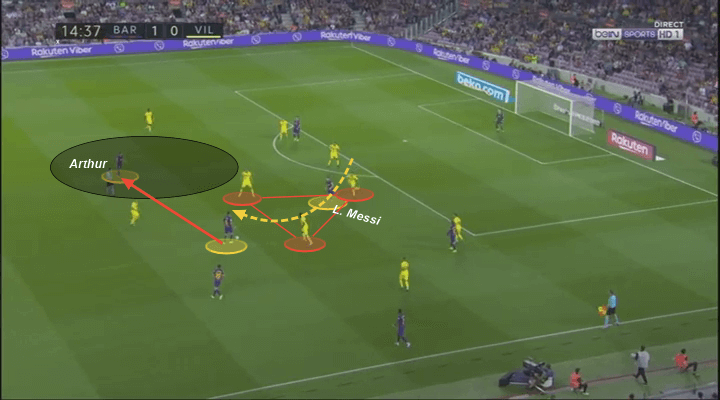
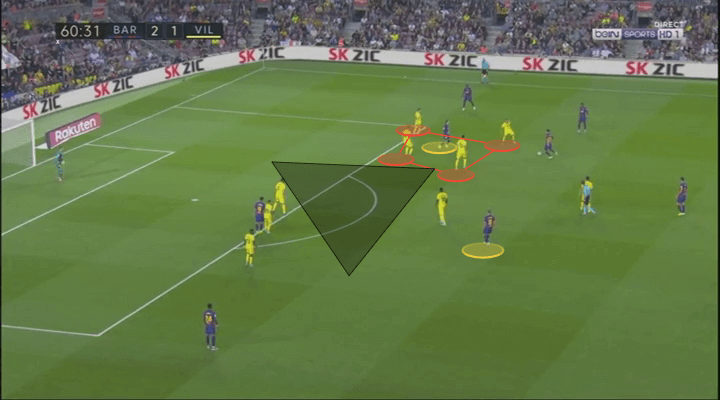
As already mentioned, due to their uncertain strategy when it comes to marking their opponents, the Villarreal players would often allow being dragged out of position, which would break their defensive structure. They would be forced to drift between different formations during the first half since Barca had the majority of the possession. The home side would release the press and switch off flanks in order to distribute the ball further.
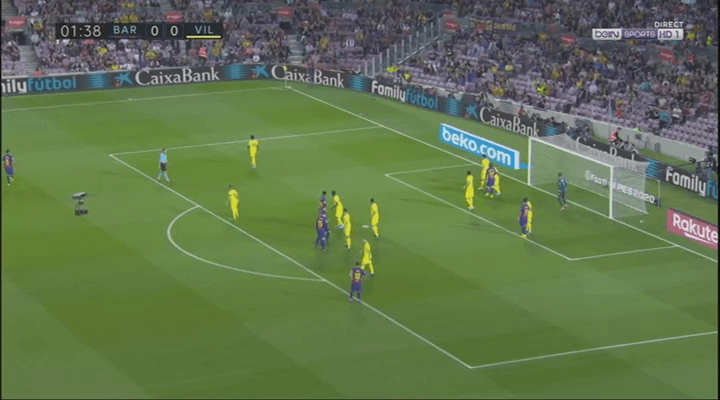
They would often use long balls behind Villarreal’s defensive line and catch them off guard using the players’ off-the-ball movement. Including Ter Stegen into these actions and using him to quickly transition into offensive actions would often help them bypass the applied press.
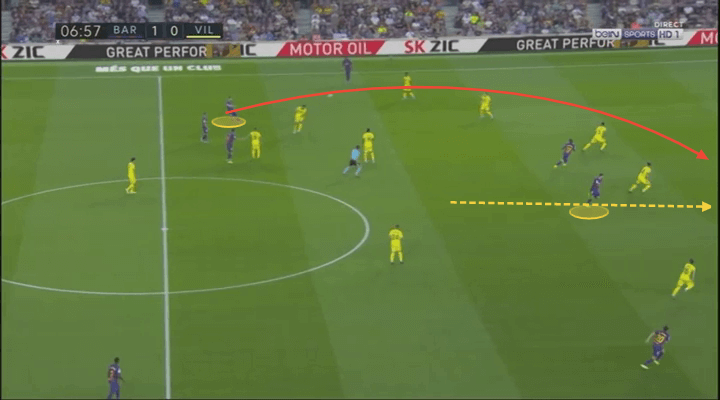
Barca’s in-game transformation
We could split Barcelona’s performance into four main stages: with Messi, without him, with De Jong and without Suárez. The team’s strategy had to completely change three times throughout the games based on these events. Having the Argentinian onside boosts their confidence immensely. The team plays in a way to be able to deliver the ball to his feet or surround him and use his vision for creating opportunities. That’s where the issue with their efficiency comes on the agenda as that doesn’t allow them to use the players’ individual abilities in the best possible way. Once he was subbed off on halftime due to injury, the team had to focus their actions towards Suárez, who would often miss out on chances as a result of his wrongly timed movement.
Messi was replaced by Dembélé, who brought freshness and creativity which resulted in them creating a few opportunities on the right. He ended up sending five crosses and made five dribble attempts whilst being active in and around the box.
The next important change Valverde did was replacing Sergi Roberto with Frenkie de Jong. The Dutch increased the pace and the creativity, contributing more to the final third actions and focusing on delivering the ball further, rather than covering the central areas.
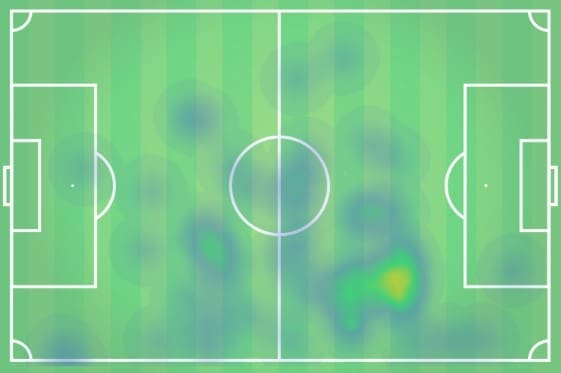
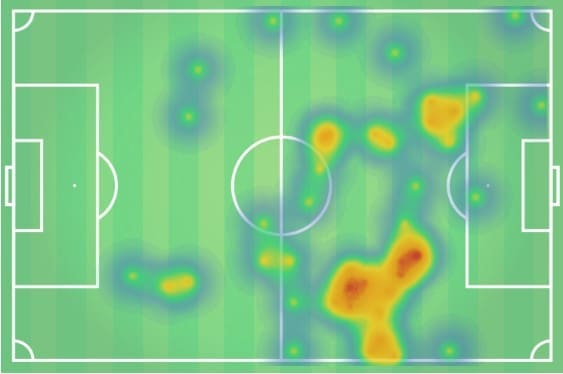
The most interesting transformation came after Suárez was subbed by Ansu Fati. Griezmann had to move to a more central position which was a huge confidence boost for him. Having the pace and vision of the youngsters surrounding him, he started playing far more freely.
Santi Cazorla is still a magician
The 34-year-old Cazorla turned out to be the best performer for his club. Despite his age and his previous struggles with injuries that almost ended his career, he showed that he still has a magic touch.

Shooting twice with a 100% accuracy and creating four shot-assists is an impressive run. His movement was perfectly measured and he was often finding his teammates in a great position to finish the attack. Drifting behind the centre forward and covering the spaces around the box turned him into a crucial part of the team’s performance. He was the main source of creativity who would complement his teammates’ movement in the best possible way. The team had 10 shots on goal, with most of them being a result of Cazorla’s 93% pass accuracy.
Conclusion
Valverde needs to find a way to involve all of his players into the action otherwise he risks making their struggles in the final third even bigger. There are some noticeable weaknesses in Barcelona’s defensive line which should be taken care of too. With the team trying to balance off La Liga and Champions League, they might experience struggles in being consistent.
Villarreal had the right attitude and were ready to get back in the game during the second half. They need to find another creative source, though, since Cazorla might not be able to carry all the games on his shoulders.

If you love tactical analysis, then you’ll love the digital magazines from totalfootballanalysis.com – a guaranteed 100+ pages of pure tactical analysis covering topics from the Premier League, Serie A, La Liga, Bundesliga and many, many more. Buy your copy of the August issue for just ₤4.99 here






Comments